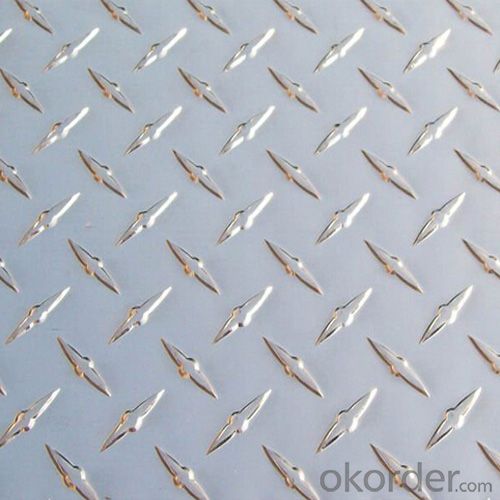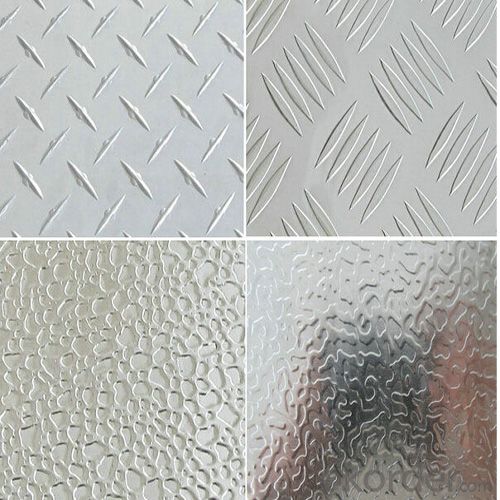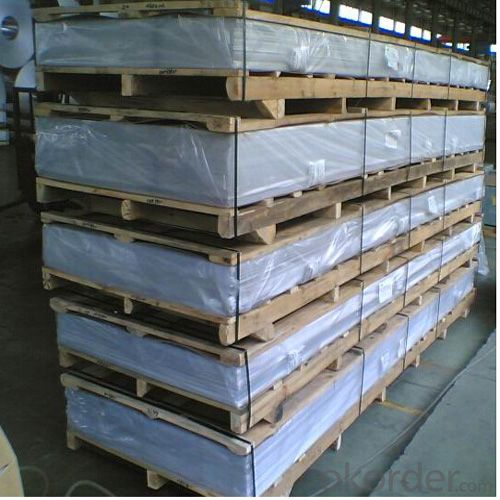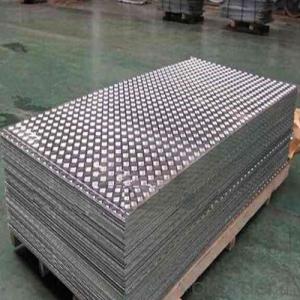Checked Embossed Aluminium Plate for Antiskid Plate
- Loading Port:
- Shanghai
- Payment Terms:
- TT OR LC
- Min Order Qty:
- 5 m.t.
- Supply Capability:
- 10000 m.t./month
OKorder Service Pledge
OKorder Financial Service
You Might Also Like
Item specifice
1.Structure of Checked Embossed Aluminium Plate for Antiskid Plate Description:
The aluminum embossed sheets are used in many places, transportation, decoration, construction, Packing and so on.The main products of our company are aluminium sheet, coil, aluminium embossed sheet, aluminium foil and aluminium circle. Aluminium embossed sheets include stucco embossed aluminium sheet, five-bars embossed aluminium sheet, diamond embossed aluminium sheet, etc. They are widely used in daily life.
2.Main Features of Checked Embossed Aluminium Plate for Antiskid Plate:
Aluminum Alloy Grade: 1050 1060 1100 3003 5052
Temper: H12, H14, H18, H22, H24, H26
Thickness: 0.8mm~5.0mm
Thickness tolerance: +/-0.01-0.04mm
3.Checked Embossed Aluminium Plate for Antiskid Plate Images:



4. Checked Embossed Aluminium Plate for Antiskid Plate Specification:
| Alloy | Si | Fe | Cu | Mn | Mg | Zn | Ti | Al |
| 1060 | 0.2 | 0.25 | 0.05 | 0.03 | 0.03 | 0.05 | 0.015-0.02 | 99.6 |
| 1050 | 0.25 | 0.40 | 0.05 | 0.05 | 0.05 | 0.05 | 0.015-0.02 | 99.5 |
| 1100 | 0.2 | 0.5-0.6 | 0.05 | 0.05 | - | 0.05 | 0.015-0.02 | 99.0 |
| 1235 | 0.65 | 0.05 | 0.05 | 0.05 | 0.1 | 0.06 | 99.35 | |
| 3003 | 0.2 | 0.3-0.45 | 0.05-0.15 | 1.05-1.35 | - | 0.10 | - | - |
| 3102 | 0.2 | 0.1-0.4 | <0.1 | 0.1-0.4 | - | <0.05 | <0.05 | - |
| 3105 | 0.6 | 0.7 | 0.3 | 0.3-0.8 | 0.2-0.8 | 0.4 | 0.1 | - |
| 5052 | 0.088 | 0.296 | 0.007 | 0.038 | 2.253 | 0.009 | 0.012 | - |
| 8011 | 0.55-0.59 | 0.69-0.75 | 0.02 | 0.025 | 0.01 | 0.01 | 0.015-0.02 | - |
| 5083 | </=0.4 | 0.4 | </=0.1 | 0.4-1.0 | 4.0-4.9 | 0.25 | </=0.15 | R |
| 5754 | 0.07 | 0.3 | 0.006 | 0.18 | - | - | 0.016 | R |
| 6061 | 0.4-0.8 | 0.7 | 0.15-0.4 | 0.15 | 0.8-1.2 | 0.25 | 0.15 | R |
| 6082 | 0.8-1.5 | 0.5 | 0.1 | 0.4-1.0 | 0.6-1.2 | 0.2 | 0.1 | R |
5.FAQ
Q1.How long have you been in this product?
A1:More than 10 years.
Q2. What's the minium quantity(MOQ)?
A2. 5 Metric tons
Q3. How long is shipping time?
A3. 7 (ready-made products)-25 days(OEM)
Q4. How do you guarantee the quality?
A4. 1. Cooperating and Exchaning experience with sevral quoted aluminum companies
2. Japanese and Swiss production line and skilled works (regular training and testing)
3. more than 10 years production experience.
Q5. Do you have after sale service?
A5. Yes. Any quality problem occurs within one year, pls take photoes,we will be responsible.
- Q:How do aluminum sheets perform in terms of electrical insulation?
- Aluminum sheets have poor electrical insulation properties as they are highly conductive materials.
- Q:What is the typical machinability of aluminum sheets?
- The typical machinability of aluminum sheets is considered to be excellent. Aluminum is known for its softness and low density, which makes it relatively easy to machine. It can be cut, drilled, and formed with relative ease, allowing for efficient and precise machining processes. However, the specific machinability of aluminum sheets can vary depending on factors such as alloy composition, temper, and thickness.
- Q:Can aluminum sheets be used for chemical distillation columns?
- Yes, aluminum sheets can be used for chemical distillation columns, particularly for low temperature and non-corrosive processes. However, it is important to note that aluminum may not be suitable for high temperature or corrosive applications, as it can react with certain chemicals and corrode. In such cases, alternative materials like stainless steel or glass may be more appropriate.
- Q:What are the common sizes of aluminum sheets?
- The common sizes of aluminum sheets vary, but some of the standard sizes include 4x8 feet, 4x10 feet, and 5x10 feet. These sizes are widely available and commonly used in various industries.
- Q:why does aluminum sheet not react with sulfuric acid nut react with hydrochloric acid?
- aluminum reacts with hydrochloric acid,generating aluminium chloride which can dissolve in water. but aluminum reacts with sulfuric acid, generating aluminum sulfate which can't dissolve in water and will generate aluminum sulfate, a layer of protective film, preventing aluminum from reacting with sulfuric acid, so there is no significant phenomena.
- Q:I'm wanting to buy colorguard poles, and I found some good deals on aluminum and fiberglass ones. But what are the pros and cons of each one?
- I'd say fiberglass because... - Durability - Aluminum is a very bendable metal. It dents, it bends, and it breaks easier than any other metal pole you'll find. This is because it's a very low density metal. - Flexibility = more dramatic twirling due to pole flex, and it's less breakable. - Counter Weight = A flag on one side of the pole would be harder to move around swiftly without a counterweight. Thus a heavier pole would entail having a center of gravity on the flag pole closer to the hand, making it easier to maneuver the flag, but the pole would be harder to lift as a whole. I'm no expert on colorguard poles, though. Fiberglass has come a long way. While aluminum is always the same material, fiberglass is a constantly evolving building material.
- Q:What are the disadvantages of using aluminum sheets?
- There are several disadvantages associated with using aluminum sheets. Firstly, aluminum is a relatively soft metal compared to other materials such as steel. This makes it more prone to denting and scratching, which can affect the overall appearance and structural integrity of the sheet. Secondly, aluminum is a highly reactive metal, especially in the presence of certain chemicals or harsh environments. It can easily corrode, leading to the formation of a white powdery substance called aluminum oxide. This corrosion can weaken the sheet and compromise its durability. Moreover, aluminum sheets are not as strong as steel sheets, which makes them less suitable for applications that require high strength and stiffness. In situations where heavy loads or extreme conditions are involved, aluminum sheets may not be able to provide the necessary structural support. Another drawback of aluminum sheets is their relatively high cost compared to other materials. The production process of aluminum involves several energy-intensive steps, making it more expensive to manufacture. This cost can be a limiting factor for projects with budget constraints. Additionally, aluminum sheets have poor thermal and electrical conductivity compared to other metals such as copper. This can be a disadvantage in applications where efficient heat transfer or electrical conductivity is required. Lastly, aluminum sheets have a lower melting point compared to steel, which limits their use in high-temperature applications. Exposing aluminum sheets to high temperatures can cause them to become weak or deform, compromising their structural integrity. Overall, while aluminum sheets have many advantages such as lightweight, corrosion resistance, and versatility, they also have several disadvantages that need to be considered depending on the specific application.
- Q:Is aluminum sheet corrosion-resistant?
- Indeed, aluminum sheet exhibits remarkable resistance to corrosion. When aluminum comes into contact with oxygen in the atmosphere, it develops a protective oxide layer that effectively hinders any further corrosion. This oxide layer acts as a shield, safeguarding the underlying metal against moisture, chemicals, and other detrimental corrosive agents. Moreover, aluminum demonstrates exceptional resistance to corrosion induced by saltwater, rendering it highly favored for marine applications. Nevertheless, it is crucial to acknowledge that specific circumstances, such as exposure to acidic or alkaline surroundings, can still induce corrosion on aluminum surfaces if not adequately preserved or shielded.
- Q:What are the different methods of surface embossing aluminum sheets?
- Aluminum sheets can be embossed using various techniques, each with its own distinct process and result. Some commonly employed methods are: 1. Mechanical Embossing: To create patterns or designs on the aluminum sheet, mechanical tools like rollers or presses are utilized. The sheet is either passed through the rollers or pressed against a surface with a pattern, which impresses the design onto the metal. Mechanical embossing is ideal for repetitive patterns like diamond or checkerplate designs. 2. Chemical Embossing: This technique involves etching or engraving the aluminum sheet using chemical solutions. The solution is selectively applied to the metal's surface, eating away the desired areas to leave an embossed pattern. Chemical embossing enables the creation of intricate and detailed designs on the aluminum sheet. 3. Heat Embossing: By applying heat, embossed designs are formed on the aluminum sheet. A heated die or stamp is pressed onto the metal's surface, causing it to deform and create the desired pattern. Heat embossing is commonly used for raised logos or text on aluminum sheets. 4. Laser Embossing: Laser technology is employed to achieve embossed designs on aluminum sheets. A laser beam is directed onto the metal's surface, vaporizing or melting the desired areas to form the embossed pattern. Laser embossing offers high precision and allows for intricate and complex designs. 5. Roll Embossing: In this method, the aluminum sheet is passed through a series of engraved rolls, which imprint the desired pattern onto the metal. Each roll has a distinct design, providing a range of embossed finishes. Roll embossing is often used for textured or decorative finishes on aluminum sheets. In conclusion, the various techniques for surface embossing aluminum sheets offer multiple options for creating visually appealing and unique designs. The choice of method depends on the desired outcome, complexity of the design, and specific project requirements.
- Q:Can aluminum sheets be used for protective enclosures?
- Aluminum sheets have the ability to be utilized for protective enclosures. This material, known for its versatility and lightweight nature, offers exceptional durability and resistance to corrosion. It can easily be transformed into various shapes and sizes, making it suitable for constructing protective enclosures across a wide range of applications. Industries such as electronics, telecommunications, aerospace, and automotive commonly employ aluminum enclosures, which safeguard against environmental factors like moisture, dust, and electromagnetic interference. Moreover, these enclosures can be further improved with the addition of coatings or insulation materials to meet specific requirements for thermal insulation, fire resistance, or electrical conductivity. All in all, aluminum sheets are a dependable option for protective enclosures due to their strength, adaptability, and capacity to endure challenging conditions.
1. Manufacturer Overview |
|
|---|---|
| Location | |
| Year Established | |
| Annual Output Value | |
| Main Markets | |
| Company Certifications | |
2. Manufacturer Certificates |
|
|---|---|
| a) Certification Name | |
| Range | |
| Reference | |
| Validity Period | |
3. Manufacturer Capability |
|
|---|---|
| a)Trade Capacity | |
| Nearest Port | |
| Export Percentage | |
| No.of Employees in Trade Department | |
| Language Spoken: | |
| b)Factory Information | |
| Factory Size: | |
| No. of Production Lines | |
| Contract Manufacturing | |
| Product Price Range | |
Send your message to us
Checked Embossed Aluminium Plate for Antiskid Plate
- Loading Port:
- Shanghai
- Payment Terms:
- TT OR LC
- Min Order Qty:
- 5 m.t.
- Supply Capability:
- 10000 m.t./month
OKorder Service Pledge
OKorder Financial Service
Similar products
New products
Hot products
Hot Searches
Related keywords





























